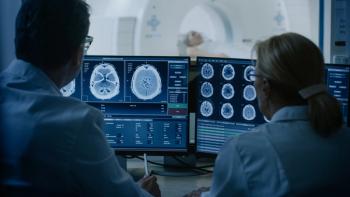
Addressing Misdiagnoses, Ensuring Accurate Diagnosis to Inform Appropriate Prescribing and Treatment for Alzheimer Disease
Symptoms of dementia can be difficult to differentiate from typical age-related behavior changes and other common and potentially curable conditions.
Following years of waiting and hoping, the Alzheimer disease (AD) community is now hailing the FDA approval of a new class of drugs that bring hope to some patients in the fight to halt the progression of AD. Better, safer treatments are still needed, especially with the overall cost for administering these medications. Researchers
AD is a progressive disorder that starts with the loss of synapses and ultimately leads to damage and the destruction of nerve cells in the brain. Over time, the disease leads to a gradual loss of cognitive functions, including the ability to remember, reason, use language and recognize familiar places. It can also cause a range of behavioral changes. The growing number of aging adults led experts to predict there will be
The opening chapter in FDA drug approvals heralds a new era of molecular therapies for AD and related neurodegenerative disorders. These first drugs attack plaques in the brain that are made of a protein called amyloid, disrupt cell function, and lead to the rapid spread of another protein called tau. Both amyloid and tau contribute to the development of AD.
In reviewing the efficacy, benefits, safety issues, and costs of each, all decision-makers can better evaluate their value. Unfortunately, patients with more advanced disease showed
Across the board, there are prescribing restrictions for all these drugs. Given the safety and cost issues associated with treatment, the need for an accurate diagnosis is paramount to ensure that the right patients receive the drug at the right time.
Background
The drug development landscape for AD has been littered with failures, with
This new class of drugs is indicated for the treatment of AD and their mechanism of action targets amyloid and tau, which are hallmarks of AD upon autopsy. This positions the evaluation of amyloid as a secondary consideration to the determination that AD is present.
Amyloid-related imaging abnormalities (ARIA) have been noted, with deaths reported in the clinical trials, some of which were attributable to the drug. The lecanemab label includes a black-box warning, requiring MRI monitoring for ARIA during the first months of treatment. The rates of ARIA vary among the therapies—from 20% to 40%—and appear to be impacted by APOE-4 genetic status.
There is also an unresolved question about the
Challenges of Diagnosis and Misdiagnosis
Symptoms of dementia can be difficult to differentiate from typical age-related behavior changes and other common and potentially curable conditions. An early diagnosis of AD can help to alleviate worry for older Americans and families and get them on the optimal AD therapeutic journey earlier in the disease trajectory.
Unfortunately, physicians have found it difficult to diagnose AD, with
Efficacy and Benefits
The benchmarks for improvement associated with each drug vary. Two clinical trials tested aducanumab and together, they
Administration
All drugs are administered as an intravenous (IV) infusion, typically performed at hospitals and infusion therapy centers: aducanumab approximately 1 hour every 4 weeks and at least 21 days apart,
Coverage Restrictions and Cost
The Centers for Medicaid & Medicare Services (CMS) maintains a restrictive policy: aducanumab coverage is reserved to only those participating in a randomized, controlled clinical trial, whereas lecanemab coverage is tied to individual physician enrollment of the patient in a CMS-run registry.
Annual costs range from aducanumab, initially priced at $56,000 and subsequently reduced to $28,200
Questions Regarding Appropriate Intervention
AD is a complicated disease with several pathologies leading to
MCI has a highly variable course of progression, with
Diagnostic Pathways
Researchers are continuing to study and develop biomarkers to improve diagnosis, keeping in mind the prevalence of misdiagnosis with AD due to the inaccuracies in current diagnostic tests, as well as the cost and access to certain tests. A recent study suggests that only
What is so encouraging is that studies show that
For example, the
Similarly, the
Brain Imaging
Several types of brain scans, including CT, MRI, and PET, may help physicians diagnose AD or a related dementia. Typically, these tests are extremely expensive and may not be available in every community.
Furthermore, the available
For example, various studies have shown that between
Cerebrospinal Fluid Biomarkers (CSF)
In clinical practice,
The most widely used CSF biomarkers for AD measure beta-amyloid 42 (the major component of amyloid plaques in the brain), tau, and phospho-tau (major components of tau tangles in the brain, which are another hallmark of AD).
Blood Biomarkers
Proteins that originate in the brain may be measured with sensitive blood tests. These blood biomarkers have historically been less accurate than CSF biomarkers for identifying AD and related dementias. Many blood biomarkers assess amyloid positivity, validated against
As noted above, patients with normal cognition may have levels of amyloid plaque consistent with AD based on a PET scan. Given that MCI and dementia can be caused by a variety of risk factors, some of which are modifiable, assessing amyloid positivity before ruling out other causes may lead to excessive diagnostic workups and potential exposure to inappropriate treatments.
Skin Test
The link between the brain and skin is documented: looking at morphological changes that take place in the skin has shown to be a useful tool in the diagnosis of AD. The introduction of DISCERN, an autopsy-validated skin test has shown
The availability of an accurate autopsy-validated test has the potential to greatly improve the identification of appropriate candidates and improve referrals to physicians who will offer these new drugs. In a recent survey, clinicians indicated that they were
DISCERN has received reimbursement PLA (CPT) codes (206U and 207U) and can be reimbursed by Medicare. The test is based on a 3 mm skin punch biopsy that is minimally-invasive and can easily be administered in the physician office setting, with the skin sample then processed in an approved laboratory.
This test is the only Autopsy-Validated Test(at98%) to identify AD and meets the NIH Gold Standard for confirming diagnostic accuracy, with patients followed for as long as 8 years prior to death. The test is comprised of 3 assays that assess the factors directly related to the formation of synaptic connections in the brain impacting loss of memory and cognition in people living with AD. The assays are also related to the formation of amyloid plaques and tau in neurofibrillary tangles, which are hallmarks of AD at autopsy.
Accurate Diagnosis is Critical
Because of the apparent safety issues associated with these risky AD drugs, and in the absence of meaningful benefits, an early and accurate AD diagnosis is critical. The emergence of an accurate test supports physician prescribing decisions and helps people avoid taking drugs such as lecanemab and donanemab, which have significant safety risks and expensive price tags.
References
- Commentary: New Class of Drugs Shifts Momentum on Alzheimer’s.
https://www.ucsf.edu/news/2023/07/425841/commentary-new-class-drugs-shifts-momentum-alzheimers - Alzheimer's Disease Facts and Figures.
https://www.alz.org/alzheimers-dementia/facts-figures#:~:text=in%20Each%20State-,Quick%20Facts,rise%20to%20nearly%2013%20million - Lilly's Alzheimer's Data for Donanemab.
https://www.science.org/content/blog-post/lilly-s-alzheimer-s-data-donanemab - Yiannopoulou KG, Anastasiou AI, Zachariou V, Pelidou SH. Reasons for Failed Trials of Disease-Modifying Treatments for Alzheimer Disease and Their Contribution in Recent Research. Biomedicines. 2019 Dec 9;7(4):97. doi: 10.3390/biomedicines7040097. PMID: 31835422; PMCID: PMC6966425.
https://www.ncbi.nlm.nih.gov/pmc/articles/PMC6966425/ - Accelerated Brain Volume Loss Caused by Anti–β-Amyloid Drugs A Systematic Review and Meta-analysis Francesca Alves, Pawel Kalinowski, Scott Ayton Neurology May 2023, 100 (20) e2114-e2124; DOI: 10.1212/WNL.0000000000207156.
https://n.neurology.org/content/100/20/e2114 - Hansson, O, Edelmayer, RM, Boxer, AL, et al. The Alzheimer's Association appropriate use recommendations for blood biomarkers in Alzheimer's disease. Alzheimer's Dement. 2022; 18: 2669–2686.
https://doi.org/10.1002/alz.12756 .https://alz-journals.onlinelibrary.wiley.com/doi/10.1002/alz.12756 - Clinical Key; How healthcare leaders can break the link between diagnostic error and delayed care;
https://cdn.baseplatform.io/files/base/ebm/hci/document/2023/07/Elseiver___Breaking_the_Link.64c8244f94dea.pdf - Woloshin S, Kesselheim AS. What to Know About the Alzheimer Drug Aducanumab (Aduhelm). JAMA Intern Med. 2022;182(8):892. doi:10.1001/jamainternmed.2022.1039.
https://jamanetwork.com/journals/jamainternalmedicine/fullarticle/2792897 - Macmillan, Carrie. Lecanemab, the New Alzheimer’s Treatment: 3 Things To Know. Yale Medicine, July 24, 2023.
https://www.yalemedicine.org/news/lecanemab-leqembi-new-alzheimers-)drug#:~:text=How%20effective%20is%20lecanemab%20for,those%20who%20received%20a%20placebo - Alzheimer’s drug, donanemab, to be FDA approved by end of 2023.
https://www.rochesterfirst.com/news/alzheimers-drug-donanemab-to-be-fda-approved-by-end-of-2023/ - Highlights of Prescribing Information.
https://www.accessdata.fda.gov/drugsatfda_docs/label/2021/761178s000lbl.pdf - Alzheimer’s NJ.Another Promising Treatment for Alzheimer’s disease. July 2023.
https://www.alznj.org/another-promising-treatment-for-alzheimers-disease/#:~:text=Donanemab%20is%20administered%20as%20an,be%20fatal%20in%20rare%20cases - Biogen Announces Reduced Price for ADUHELM® to Improve Access for Patients with Early Alzheimer’s Disease, December 2021.
https://investors.biogen.com/news-releases/news-release-details/biogen-announces-reduced-price-aduhelmr-improve-access-patients - Cubanski, Juliette.New Alzheimer’s Drugs Spark Hope for Patients and Cost Concerns for Medicare.Kaiser Family Foundation, July 6, 2023.
https://www.kff.org/policy-watch/new-alzheimers-drugs-spark-hope-for-patients-and-cost-concerns-for-medicare/#:~:text=At%20Leqembi's%20current%20%2426%2C500%20list,coinsurance%20requirement%20in%20traditional%20Medicare - Iskowitz, Marc. Lilly’s Alzheimer’s Drug Donanemab Shows Promise as Leqembi Showdown Looms.Medical Marketing and Media, July 18, 2023.
https://www.mmm-online.com/home/channel/lillys-alzheimers-drug-donanemab-shows-promise-as-leqembi-showdown-looms/#:~:text=Such%20data%20will%20also%20help,would%20not%20be%20cost%2Deffective - Herrup, K. The case for rejecting the amyloid cascade hypothesis. Nat Neurosci 18, 794–799 (2015).
https://doi.org/10.1038/nn.4017 .https://www.nature.com/articles/nn.4017 - Nyenhuis, D. (2015). Vascular cognitive impairment. In P. A. Lichtenberg, B. T. Mast, B. D. Carpenter, & J. Loebach Wetherell (Eds.), APA handbook of clinical geropsychology, Vol. 2. Assessment, treatment, and issues of later life (pp. 209–226). American Psychological Association.
https://doi.org/10.1037/14459-008 .https://psycnet.apa.org/record/2014-19597-008 - ALZ Forum. In the U.S., 40 Percent of All-Cause Dementia Is Preventable, July 2022.
https://www.alzforum.org/news/research-news/us-40-percent-all-cause-dementia-preventable - Eligibility for Anti-Amyloid Treatment in a Population-Based Study of Cognitive Aging Rioghna R Pittock, Jeremiah Aakre, Anna M Castillo, Vijay K Ramanan, Walter K. Kremers, Clifford R. Jack, Prashanthi Vemuri, Val J. Lowe, David S Knopman, Ronald C Petersen, Jonathan Graff-Radford, Maria Vassilaki Neurology Aug 2023, 10.1212/WNL.0000000000207770; DOI: 10.1212/WNL.0000000000207770.
https://n.neurology.org/content/early/2023/08/16/WNL.0000000000207770 - Rolandi, E., Zaccaria, D., Vaccaro, R. et al. Estimating the potential for dementia prevention through modifiable risk factors elimination in the real-world setting: a population-based study. Alz Res Therapy 12, 94 (2020).
https://doi.org/10.1186/s13195-020-00661-y .https://alzres.biomedcentral.com/articles/10.1186/s13195-020-00661-y . - Baker, L.D., Cotman, C.W., Thomas, R., Jin, S., Shadyab, A.H., Pa, J., Rissman, R.A., Brewer, J.B., Zhang, J., Jung, Y., LaCroix, A.Z., Messer, K. and Feldman, H.H. (2022), Topline Results of EXERT: Can Exercise Slow Cognitive Decline in MCI?. Alzheimer's Dement., 18: e069700.
https://doi.org/10.1002/alz.069700 .https://alz-journals.onlinelibrary.wiley.com/doi/10.1002/alz.069700 - Yaffe K, Barnes DE, Rosenberg D, Dublin S, Kaup AR, Ludman EJ, Vittinghoff E, Peltz CB, Renz AD, Adams KJ, Larson EB. Systematic Multi-Domain Alzheimer's Risk Reduction Trial (SMARRT): Study Protocol. J Alzheimers Dis. 2019;70(s1):S207-S220. doi: 10.3233/JAD-180634. PMID: 30475764; PMCID: PMC6639147.
https://pubmed.ncbi.nlm.nih.gov/30475764/ - Teipel, SJ, Spottke, A, Boecker, H, et al. Patient-related benefits of amyloid PET imaging in dementia: Rationale and design of the German randomized coverage with evidence development study ENABLE. Alzheimer's Dement. 2023; 9:e12383.
https://doi.org/10.1002/trc2.12383 .https://alz-journals.onlinelibrary.wiley.com/doi/10.1002/trc2.12383 - Potential for misdiagnosis in community-acquired PET scans for dementia Sheena M. Shipley, Meredith C. Frederick, Christopher M. Filley, Benzi M. Kluger Neurol Clin Pract Aug 2013, 3 (4) 305-312; DOI: 10.1212/CPJ.0b013e318296f2df.
https://doi.org/10.1212/CPJ.0b013e318296f2df - Katzman, R., Terry, R., DeTeresa, R., Brown, T., Davies, P., Fuld, P., Renbing, X. and Peck, A. (1988), Clinical, pathological, and neurochemical changes in dementia: A subgroup with preserved mental status and numerous neocortical plaques. Ann Neurol., 23: 138-144.
https://doi.org/10.1002/ana.410230206 .https://onlinelibrary.wiley.com/doi/10.1002/ana.410230206 - Jack CR, Therneau TM, Weigand SD, et al. Prevalence of Biologically vs Clinically Defined Alzheimer Spectrum Entities Using the National Institute on Aging–Alzheimer’s Association Research Framework. JAMA Neurol. 2019;76(10):1174–1183. doi:10.1001/jamaneurol.2019.1971.
https://doi.org/10.1001/jamaneurol.2019.1971 - What Is Dementia? Symptoms, Types, and Diagnosis.
https://www.nia.nih.gov/health/what-is-dementia - Cerebrospinal Fluid Culture.
https://www.healthline.com/health/cerebrospinal-fluid-culture#next-steps - Cerebrospinal fluid (CSF) collection.
https://medlineplus.gov/ency/article/003428.htm - Hu Y, Kirmess KM, Meyer MR, et al. Assessment of a Plasma Amyloid Probability Score to Estimate Amyloid Positron Emission Tomography Findings Among Adults With Cognitive Impairment. JAMA Netw Open. 2022;5(4):e228392. doi:10.1001/jamanetworkopen.2022.8392.
https://jamanetwork.com/journals/jamanetworkopen/fullarticle/2791438 - Chirila, F.V., Xu, G., Fontaine, D. et al. Morphometric imaging biomarker identifies Alzheimer’s disease even among mixed dementia patients. Sci Rep 12, 17675 (2022).
https://doi.org/10.1038/s41598-022-21796-y . - Datar M, Mark N, Samson C (2022) Clinical Utility of a Novel Test to Diagnose Alzheimer’s Disease in Patients with Suspected Dementia. Ann Clin Cytol Pathol 8(1): 1143.
https://www.jscimedcentral.com/public/assets/articles/clinicalcytology-8-1143.pdf
Newsletter
Stay informed on drug updates, treatment guidelines, and pharmacy practice trends—subscribe to Pharmacy Times for weekly clinical insights.


















































































































































































































